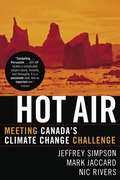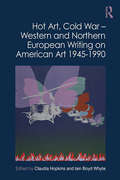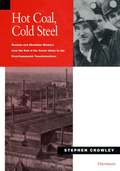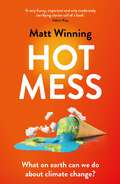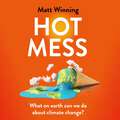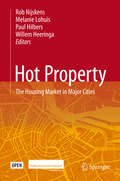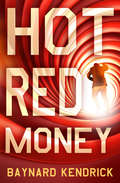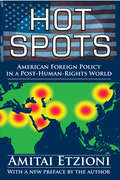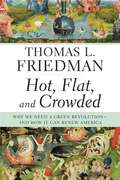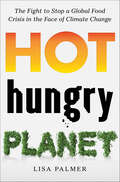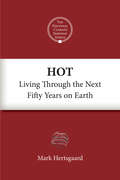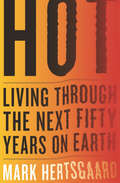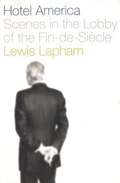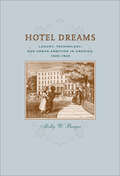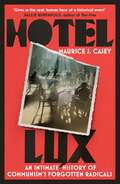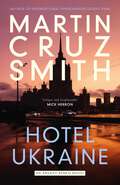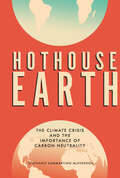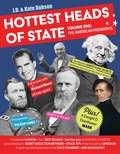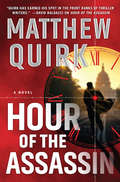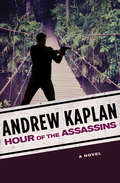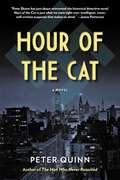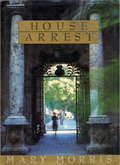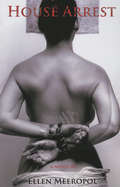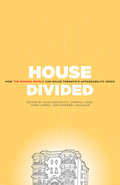- Table View
- List View
Hot Air: Meeting Canada's Climate Change Challenge
by Jeffrey Simpson Nic Rivers Mark JaccardHere's a clear, believable book for Canadians concerned about our situation -- and it offers a solution. It's a brilliant mix. To "Canada's best mind on the environment," Mark Jaccard, who won the 2006 Donner Prize for an academic book in this area, you add Nic Rivers, a researcher who works with him at Simon Fraser University. Then you add Jeffrey Simpson, the highly respected Globe and Mail columnist, to punch the message home in a clear, hard-hitting way. The result is a unique book.Most other books on energy and climate change are: (a) terrifying or (b) academic or (c) quirky, advocating a single, neat solution like solar or wind power. This book is different. It starts with an alarming description of the climate threat to our country. Then it shifts to an alarming description of how Canadians have been betrayed by their politicians ("We're working on it!"), their industrialists ("Things aren't that bad, really, and voluntary guidelines will be good enough."), and even their environmentalists ("Energy efficiency can be profitable, and people can change their lifestyles!") All of this, of course, reinforces the myths that forceful policies are not needed. Hot Air then lays out in convincing and easily understandable terms the few simple policies that Canada must adopt right away in order to significantly reduce greenhouse gas emissions over the next few decades. It even shows how these policies can be designed to have minimal negative effects. With evidence from other countries that are successfully addressing climate change, Hot Air shows why these are the only policies that will work -- and why this is a matter of life and death for all of us.
Hot Art, Cold War – Western and Northern European Writing on American Art 1945-1990: Western and Northern European Writing on American Art 1945 to 1990
by Claudia HopkinsHot Art, Cold War – Northern and Western European Writing on American Art 1945-1990 is one of two text anthologies that trace the reception of American art in Europe during the Cold War era through primary sources. With the exception of those originally published in English, the majority of these texts are translated into English for the first time from eight languages, and are introduced by scholarly essays. They offer a representative selection of the diverse responses to American art in Great Britain, Ireland, France, Belgium, the Netherlands, West Germany (FRG), Austria, Switzerland, Denmark, Norway, Sweden, and Finland. There was no single European discourse, as attitudes to American art were determined by a wide range of ideological, political, social, cultural and artistic positions that varied considerably across the European nations. This volume and its companion, Hot Art, Cold War – Southern and Eastern European Writing on American Art 1945-1990, offer the reader a unique opportunity to compare how European art writers introduced and explained contemporary American art to their many and varied audiences. Whilst many are fluent in one or two foreign languages, few are able to read all twenty-five languages represented in the two volumes. These ground-breaking publications significantly enrich the fields of American art studies and European art criticism.
Hot Coal, Cold Steel: Russian and Ukrainian Workers from the End of the Soviet Union to the Post-communist Transformations
by Stephen CrowleyWell after the disintegration of the Communist Party and the Soviet state--and through several years of economic collapse--industrial workers in almost every sector of the former Soviet Union have remained quiescent and the same ineffective and unpopular trade unions still hold a virtual monopoly on worker's representation. Why? While many argue that labor is a central variable in the development of economic and political systems, little is known about workers in the states of the former Soviet Union since the fall of Communism. In a comparative study of two groups of industrial workers--the coal miners and steelworkers--at the end of the Soviet era, Stephen Crowley sheds light on where these workers have been and where they are going. Coal miners in the final years of the Soviet Union effectively organized and led strikes which supported the end of Communism, even though their heavy subsidies would be threatened by capitalism. Steel workers, in contrast, did not effectively organize and strike. This pattern has continued under the new governments, with the coal miners effectively organized and seeking protection from the worst consequences of marketization, while the steel workers remain weakly organized despite deteriorating economic conditions. Based on extensive on-site research including interviews with miners and steelworkers, labor leaders and plant managers, Crowley develops a detailed picture of the conditions under which workers organize. His findings have application beyond the conditions of post-Communist Russia and Ukraine to other societies undergoing fundamental change.
Hot Mess: What on earth can we do about climate change?
by Matt Winning'A very funny, important and only moderately terrifying clarion call of a book' - Adam Kay'HOT MESS provides loads of laughs about "the climate situation" and will position you at the right point between fear and determination' - Mark Watson 'Hilarious, informative and worrying in equal measure. And that's just the bits about having a baby' - Josie LongFor fans of Randall Munro's WHAT IF? Matt Parker's HUMBLE PI and anyone looking for practical tips on how to stop the end of the world!Dr Matt Winning is a stand-up comedian and environmental economist with a PHD in climate change policy, which means he's the sort of doctor who will rush to your side if you fall ill on a plane, but only to berate you for flying. We are currently facing a global climate emergency. You've probably noticed. But why does the end of the world need to be so depressing? HOT MESS aims to both lighten the mood and enlighten readers on climate change. This is a book for people who care about climate change but aren't doing much about it, helping readers understand what the main causes of climate change are, what changes are needed, and what they can (and cannot) do about it. But, most importantly, it is book that'll help people find the comedy in climate change, because if we can do that, well, we can do bloody anything.'Climate change is no laughing matter - oh yes it is - with Matt Winning's superb, hilarious, side-splitting book that makes you take a whole new look at the climate crisis, surviving having children and life in general' - Mark Maslin, author of How to Save Our Planet'The first book about climate change that made me laugh out loud. If you've been too freaked out to subject yourself to the climate crisis, Hot Mess is the kick in the pants you need to start making yourself useful.' - Prof. Kimberly Nicholas, author of Under the Sky We Make: How to Be Human in a Warming World
Hot Mess: What on earth can we do about climate change?
by Matt Winning'A very funny, important and only moderately terrifying clarion call of a book' - Adam Kay'HOT MESS provides loads of laughs about "the climate situation" and will position you at the right point between fear and determination' - Mark Watson 'Hilarious, informative and worrying in equal measure. And that's just the bits about having a baby' - Josie LongFor fans of Randall Munro's WHAT IF? Matt Parker's HUMBLE PI and anyone looking for practical tips on how to stop the end of the world!Dr Matt Winning is a stand-up comedian and environmental economist with a PHD in climate change policy, which means he's the sort of doctor who will rush to your side if you fall ill on a plane, but only to berate you for flying. We are currently facing a global climate emergency. You've probably noticed. But why does the end of the world need to be so depressing? HOT MESS aims to both lighten the mood and enlighten readers on climate change. This is a book for people who care about climate change but aren't doing much about it, helping readers understand what the main causes of climate change are, what changes are needed, and what they can (and cannot) do about it. But, most importantly, it is book that'll help people find the comedy in climate change, because if we can do that, well, we can do bloody anything.'Climate change is no laughing matter - oh yes it is - with Matt Winning's superb, hilarious, side-splitting book that makes you take a whole new look at the climate crisis, surviving having children and life in general' - Mark Maslin, author of How to Save Our Planet'The first book about climate change that made me laugh out loud. If you've been too freaked out to subject yourself to the climate crisis, Hot Mess is the kick in the pants you need to start making yourself useful.' - Prof. Kimberly Nicholas, author of Under the Sky We Make: How to Be Human in a Warming World
Hot Mess: What on earth can we do about climate change?
by Matt WinningWhat is climate change, who's to blame, and what the f**k can we do about it? Award-winning comedian and climate change researcher Dr Matt Winning explains all.For fans of Randall Munro's WHAT IF? Matt Parker's HUMBLE PI and anyone looking for practical tips on how to stop the end of the world!Dr Matt Winning is a stand-up comedian and environmental economist with a PHD in climate change policy, which means he's the sort of doctor who will rush to your side if you fall ill on a plane, but only to berate you for flying. We are currently facing a global climate emergency. You've probably noticed. But why does the end of the world need to be so depressing? HOT MESS aims to both lighten the mood and enlighten readers on climate change. This is a book for people who care about climate change but aren't doing much about it, helping readers understand what the main causes of climate change are, what changes are needed, and what they can (and cannot) do about it. But, most importantly, it is book that'll help people find the comedy in climate change, because if we can do that, well, we can do bloody anything.(P) 2021 Headline Publishing Group Ltd
Hot Property: The Housing Market in Major Cities
by Paul Hilbers Rob Nijskens Melanie Lohuis Willem HeeringaThis open access book discusses booming housing markets in cities around the globe, and the resulting challenges for policymakers and central banks. Cities are booming everywhere, leading to a growing demand for urban housing. In many cities this demand is out-pacing supply, which causes house prices to soar and increases the pressure on rental markets. These developments are posing major challenges for policymakers, central banks and other authorities responsible for ensuring financial stability, and economic well-being in general.This volume collects views from high-level policymakers and researchers, providing essential insights into these challenges, their impact on society, the economy and financial stability, and possible policy responses. The respective chapters address issues such as the popularity of cities, the question of a credit-fueled housing bubble, the role of housing supply frictions and potential policy solutions. Given its scope, the book offers a revealing read and valuable guide for everyone involved in practical policymaking for housing markets, mortgage credit and financial stability.
Hot Red Money
by Baynard KendrickA reporter is entangled in a Cold War conspiracy in this Golden Age thriller by the acclaimed author of the Duncan Maclain Mysteries.Maurice Morel has had a successful career as a journalist. Reporting on Soviet activities in the United States, he digs out and exposes Communist coverups. His byline regularly runs on the front page of the New York Evening Globe-Star, and he&’s even won a Pulitzer Prize. But he&’s also garnered a few enemies along the way . . .Now, Maury&’s in disguise for a midnight meeting in a secluded café with a Lebanese sailor who supposedly has valuable information. There&’s fifteen billion dollars in Soviet gold tucked away in Swiss and Lebanese banks, and the man controlling the money is in America. He&’s using an alias and he&’s up to something.Maury&’s not sure he can believe his source. He needs cold hard facts. Sadly, the proof comes when he discovers the seaman knifed in an alley. Now Maury knows he has a big story on his hands. He simply needs to follow the sailor&’s lead—and not get caught by the men following him . . .Baynard Kendrick was a founding member of the Mystery Writers of America, the holder of the organization&’s first membership card, and a winner of its Grand Master Award.
Hot Spots: American Foreign Policy in a Post-Human-Rights World
by Amitai EtzioniThere are important reasons for the distinct yet significant course adjustments in American and Western foreign policy, which is currently focused on the Middle Eastern and Chinese "hot spots." In early 2012, the United States "pivoted" to make the Far East its military and strategic first priority, thereby downgrading the Middle East. This change in priorities has been accompanied by a curtailed military budget and the end of the two-war doctrine.Amitai Etzioni argues that pivoting towards the Far East is premature and flawed in principle. China can and should be treated for the near future as a potential partner in a changing global order, rather than contained and made into an enemy. At the same time, he argues, the true hot spots continue to be in the Middle East, albeit not in Iraq or Afghanistan, but in Iran and Pakistan. Less urgent but of great importance are the ways the West deals with a complex and varied Muslim world, with political Islamic parties and social movements, and with future waves of Arab awaking. Here the distinction between security and nation building becomes essential for both normative and strategic reasons.Etzioni expects that we will see few armed humanitarian interventions of the kind we witnessed in 2011 in Libya. To this end, he examines policies that threaten and favor the promotion of human rights. This timely book is written with Etzioni's customary deep appreciation for important issues.
Hot, Flat, and Crowded: Why We Need a Green Revolution - and How It Can Renew America
by Thomas L. FriedmanFriedman shows how the 2 biggest crises of today (America's loss of focus since 9/11 and the global environment crisis) are linked and how we can restore the world and revive America at the same time
Hot, Hungry Planet: The Fight to Stop a Global Food Crisis in the Face of Climate Change
by Lisa PalmerEarth will have more than 9.6 billion people by 2050 according to U.N. predictions. With resources already scarce, how will we feed them all? Journalist Lisa Palmer has traveled the world for years documenting the cutting-edge innovations of people and organizations on the front lines of fighting the food gap. Here, she shares the story of the epic journey to solve the imperfect relationship between two of our planet’s greatest challenges: climate change and global hunger.Hot, Hungry Planet focuses on three key concepts that support food security and resilience in a changing world: social, educational, and agricultural advances; land use and technical actions by farmers; and policy nudges that have the greatest potential for reducing adverse environmental impacts of agriculture while providing more food. Palmer breaks down this difficult subject though seven concise and easily-digestible case studies over the globe and presents the stories of individuals in six key regions—India, sub-Saharan Africa, the United States, Latin America, the Middle East, and Indonesia—painting a hopeful picture of both the world we want to live in and the great leaps it will take to get there.
Hot: Living Through the Next Fifty Years on Earth
by Mark Hertsgaard Eban GoodsteinOn December 7, 2011, Mark Hertsgaard participated in The National Climate Seminar, a series of webinars sponsored by Bard College's Center for Environmental Policy. The online seminars provide a forum for leading scientists, writers, and other experts to talk about critical issues regarding climate change. The series also opens a public conversation, inviting participants to ask questions and contribute their own thoughts. Hertsgaard has spent the last two decades reporting on climate change for media outlets including The New Yorker, NPR, Time, Vanity Fair, and The Nation, where he is the environment correspondent. His lecture focused on political movements and how environmental advocates can provoke change in public attitudes and on Capitol Hill. Hertsgaard sees 2011's Occupy movement as a sign of real hope and discussed what climate activists can learn from Occupy's tactics. This E-ssential is an edited version of Hertsgaard's talk and the subsequent question and answer session. While some material has been cut and some language modified for clarity, the intention was to retain the substance of the original discussion.
Hot: Living Through the Next Fifty Years on Earth (National Climate Seminar Ser. #5)
by Mark HertsgaardA fresh take on climate change by a renowned journalist driven to protect his daughter, your kids, and the next generation who'll inherit the problem For twenty years, Mark Hertsgaard has investigated global warming for outlets including the New Yorker, NPR, Time, Vanity Fair, and The Nation. But the full truth did not hit home until he became a father and, soon thereafter, learned that climate change had already arrived-a century earlier than forecast-with impacts bound to worsen for decades to come. Hertsgaard's daughter Chiara, now five yea rs old, is part of what he has dubbed "Generation Hot"--the two billion young people worldwide who will spend the rest of their lives coping with mounting climate disruption. HOT is a father's cry against climate change, but most of the book focuses on s olutions, offering a deeply reported blueprint for how all of us-as parents, communities, companies and countries-can navigate this unavoidable new era. Combining reporting from across the nation and around the world with personal reflections on his daugh ter's future, Hertsgaard provides "pictures" of what is expected over the next fifty years: Chicago's climate transformed to resemble Houston's; dwindling water supplies and crop yields at home and abroad; the redesign of New York and other cities against mega-storms and sea-level rise. Above all, he shows who is taking wise, creative precautions. For in the end, HOT is a book about how we'll survive.
Hotel America: Scenes in the Lobby of the Fin-de-Siècle
by Lewis H. LaphamLapham's observations speak to the moral and intellectual confusions visited upon the American ruling elites - in the media and the universities as well as in business and government during the years 1989-1995. Drawn across a broad canvas of incidental and scene. Lapham's sketches take as their occasions events as different from one another as the wars in Panama and the Persian Gulf, the apotheosis of Richard Nixon and the transfiguration of O. J. Simpson, the grim inspections of the American soul conducted by the agents of both the pious left (no smoking cigarettes, no dirty water in the swimming pools, condoms in the schools) and the zealous right (no serial murders in the movies, no lesbians in the army, prayer in the schools), the media's use of history as wallpaper and elevator music, the dwindling significance of President Clinton (vanishing as mysteriously as the Cheshire cat) and the bombastic arrival of Newt Gingrich ("a man for all grievances"), the practice of swindling the stockholders and the art of changing gossip into news.
Hotel Dreams: Luxury, Technology, and Urban Ambition in America, 1829–1929 (Studies in Industry and Society)
by Molly W. BergerWinner, 2012 Sally Hacker Prize, Society for the History of TechnologyHotel Dreams is a deeply researched and entertaining account of how the hotel's material world of machines and marble integrated into and shaped the society it served. Molly W. Berger offers a compelling history of the American hotel and how it captured the public's imagination as it came to represent the complex—and often contentious—relationship among luxury, economic development, and the ideals of a democratic society.Berger profiles the country's most prestigious hotels, including Boston's 1829 Tremont, San Francisco's world-famous Palace, and Chicago's enormous Stevens. The fascinating stories behind their design, construction, and marketing reveal in rich detail how these buildings became cultural symbols that shaped the urban landscape.
Hotel Lux: An Intimate History of Communism's Forgotten Radicals
by Maurice CaseyThe extraordinary story of a group of forgotten radicals who found themselves drawn to communist Moscow&’s hotbed of international revolutionary activity: the Hotel Lux. Hotel Lux follows Irish radical May O&’Callaghan and her friends, three revolutionary families brought together by their vision for a communist future and their time spent in the Comintern&’s Moscow living quarters, the Hotel Lux. Historian Maurice Casey reveals the connections and disconnections of a group of forgotten communist activists whose lives collided in 1920s Moscow: a brilliant Irish translator, a maverick author, the rebel daughters of an East London Jewish family, and a family of determined German anti-fascists. The dramatic and interlocking histories of the O&’Flahertys, Cohens and Leonhards offer an intimate insight into the legacies of the Russian Revolution from its earliest idealism through to the brutal Stalinist purges and beyond. Hotel Lux uncovers a world of forgotten radicals who saw their hopes and dreams crash against reality yet retained their faith in a beautiful future for all. Culminating in a queer love story that saw the daughters of the Cohens and Leonhards create an enduring partnership even as their parents&’ political visions crumbled, this is a multi-generational rebel odyssey and a history of international communism, one which looks as much to the future as it does to the past.
Hotel Ukraine: The brand new Arkady Renko political thriller, from one of the undisputed masters of the genre
by Martin Cruz SmithArkady Renko returns in this tense political thriller, from one of the undisputed masters of the genre. When Arkady Renko is charged with investigating the murder of Alexei Kazasky, the Deputy Minister of Defence, he knows he has to tread carefully. Alexei Kazasky is a high-profile politician and has a complicated relationship with Putin. This investigation clearly has Kremlin approval, but, as with everything in Russia, things are not always what they seem. Already preoccupied with his developing Parkinson&’s, Arkady finds he has more to worry about. The war in Ukraine is gaining momentum, and his adopted son Zhenya has become involved with the Black Army, a Russo-Ukrainian group of hacktivists. Moreover, as Arkady digs deeper into Kazasky&’s murder, he realizes that the man&’s death may have been more politically motivated than he first assumed. Now it seems that the people behind the killing have him firmly in their crosshairs – but this time Arkady&’s life is not the only one on the line.PRAISE FOR MARTIN CRUZ SMITH: 'Does more on a page than most writers manage in a chapter. He is unique and irreplaceable' Mick Herron 'Among the first of a new generation of writers who made thrillers literary' Guardian 'One of those writers that anyone who is serious about their craft views with respect bordering on awe' Val McDermid 'The undisputed master of the political crime thriller' Abir Mukherjee 'One of the finest writers of our age' Charlotte Philby
Hothouse Earth: The Climate Crisis and the Importance of Carbon Neutrality
by Stephanie Sammartino McPhersonAs hurricanes, droughts, floods, and wildfires are increasing in regularity and intensity, climate change can no longer be ignored. Melting permafrost, forest dieback, ocean acidification, and other processes are creating positive feedback loops which could, if not aggressively and quickly addressed, spiral out of control and take global warming past the point of no return. Hothouse Earth examines how science, politics, and social justice must all be part of the equation to counteract climate change.
Hottest Heads of State: The American Presidents
by J. D. Dobson Kate DobsonTigerBeat for U.S. presidents—a tour of our nation’s history through its irresistible commanders-in-chief Is there anything hotter than former U.S. presidents? Obviously, there is not. And yet, until now, there was no way to learn about these handsome and mysterious men that is funny, educational, and includes thoughtful analysis of which ones would make good boyfriends. Thankfully, Hottest Heads of State fills this void. Get to know each president intimately with an individual profile outlining his particular charms (or, in some cases, “charms”). Plus, inside you’ll find:· GAMES including “Match the Mistress to her POTUS” · QUIZZES like “Which President has a Secret Crush on You?” and “Can You Cover Up Watergate?”· that POSTER of Rutherford B. Hayes you’ve always secretly wanted! J. D. and Kate Dobson’s wickedly smart and refreshingly bipartisan debut is a spot-on parody of a teen magazine featuring such unlikely heartthrobs as Richard Nixon and William H. Taft. In the end, you’ll learn centuries’ worth of cocktail party-worthy trivia, and you’ll be slightly more prepared to take the AP U.S. History exam. You’ll also start tingling whenever you hear the name Herbert Hoover.
Hour of the Assassin: A Novel
by Matthew Quirk“Quirk has earned his spot in the front ranks of thriller writers. Opens with a bang and keeps exploding for three hundred pages." —David Baldacci, New York Times bestselling author of A Minute to MidnightFramed and on the run for his life, a former Secret Service agent discovers how far some men will go to grasp the highest office in the land in this electrifying tale from the author of The Night Agent—a propulsive political thriller reminiscent of the best early Baldacci and Grisham novels.As a Secret Service agent, Nick Averose spent a decade protecting the most powerful men and women in America and developed a unique gift: the ability to think like an assassin. Now, he uses that skill in a little-known but crucial job. As a “red teamer,” he poses as a threat, testing the security around our highest officials to find vulnerabilities—before our enemies can. He is a mock killer, capable of slipping past even the best defenses.His latest assignment is to assess the security surrounding the former CIA director at his DC area home. But soon after he breaches the man’s study, the home’s inner sanctum, Nick finds himself entangled in a vicious crime that will shake Washington to its foundations—as all the evidence points to Nick.Nick knows he’s the perfect scapegoat. But who is framing him, and why? To clear his name, he must find the truth—a search that leads to a dark conspiracy whose roots stretch back decades. The prize is the most powerful position in the world: the Oval Office.To save himself and the people he loves, Nick must stop the men who rule Washington before they bury him along with their secrets. “This one is a gritty, intense political thriller, filled with nuance and dire exploits. Totally entertaining. A treat from start to finish. —Steve Berry, author of The Malta Exchange
Hour of the Assassins: A Novel
by Andrew KaplanTo prevent the rebirth of the Nazi regime, an ex-CIA agent turns SS hunter in this thriller of deception, buried history, and a far-reaching conspiracy. In the hell of Auschwitz, the devil was named Mengele. His atrocities were unspeakable, and among his victims were the wife and child of a man named Wasserman, who was forced to watch them die. Mengele survived the war, disappearing into hiding in South America, and Wasserman ran too—fleeing to the United States to make a fortune as a Hollywood porn king. Now he is dying of cancer, but before he goes, he wants Mengele dead. To see the Angel of Death hunted down and killed, Wasserman recruits former Vietnam vet and ex-CIA agent John Caine. Caine&’s journey into the heart of darkness takes him from a neo-Nazi Odessa network in Paraguay to Jerusalem to a sinister cadre in Vienna and finally to the South American jungles. It is here, deep in the Amazon, that Caine believes he&’s met his match—a doctor revered by the headhunting natives, and determined to keep his isolated clinic a secret from the civilized world. But Caine&’s mission is only beginning. The victim of a shocking deception, he&’ll soon be the hunted, as an unwitting key player in one of the greatest conspiracies of our time. From a master of the spy thriller, the author of the award-winning novels based on the Showtime series Homeland: Carrie&’s Run and Homeland: Saul&’s Game, this is a tale of twists and vengeance that&’s &“like a ride on the Magic Mountain rollercoaster&” (Los Angeles Times).
Hour of the Cat (The Fintan Dunne Trilogy)
by Peter QuinnIt’s just another murder, one of the hundreds of simple homicides in 1939: A spinster nurse is killed in her apartment; a suspect is caught with the murder weapon and convicted. Fintan Dunne, the P.I. lured onto the case and coerced by conscience into unraveling the complex setup that has put an innocent man on Death Row, will soon find that this is a murder with tentacles which stretch far beyond the crime scene . . . to Nazi Germany, in fact; following it to the end leads him into a murder conspiracy of a scope that defies imagination. The same clouds are rolling over Berlin, where plans for a military coup are forming among a cadre of Wehrmacht officers. Admiral Wilhelm Canaris, head of the Military Intelligence, is gripped by a deadly paralysis: He is neither with the plotters nor against them. Joining them in treason would violate every value he holds as an officer. Betraying the plotters to the Gestapo Chief, Reinhard Heydrich, might just forsake the country’s last hope to avert utter destruction and centuries of shame. Heydrich is suspicious. With no limits to Hitler’s manic pursuit of territorial expansion, with crimes against the people candy-coated as racial purification, the “hour of the cat” looms when every German conscience must make a choice. When Canaris receives an order to assist in a sinister covert operation on foreign shores, his hour has come. Hour of the Cat is a stunning achievement: tautly suspenseful, hauntingly memorable, and brilliantly authentic.
House Arrest
by Mary MorrisMary Morris, called "a marvelous storyteller" by The Chicago Tribune , returns with the finest novel in her acclaimed career--a vividly etched, engrossing story of a nation, two remarkable women, and the meaning of freedom. Taut with tension, filled with the telling observations of place and local character that grow out of her expertise as a travel writer, House Arrest is Mary Morris's richest, most powerful novel to date.
House Arrest: A Novel
by Ellen MeeropolA visiting nurse forms a bond with a young female cult member in this &“fascinating&” novel (Rosellen Brown, New York Times–bestselling author of The Lake on Fire). Home-care nurse Emily Klein has been assigned to make prenatal visits to an unusual client: Pippa Glenning, a cult member whose daughter died during a Solstice ceremony—an event for which she is under arrest, spared imprisonment for now and allowed home confinement only because of her pregnancy. Emily cannot help but feel compassion for Pippa, especially in light of her own family history. But everyone warns her not to get too close . . . Set in Springfield, Massachusetts and on an island in Penobscot Bay, the story is told in alternating points of view—all centering on the theme of political activism and its consequences, especially when politics become personal. House Arrest explores the meaning of family loyalty when beliefs conflict, and the question of when breaking the rules serves justice. &“[A] strong first novel . . . thoughtful and tightly composed, unflinching in taking on challenging subjects and deliberating uneasy ethical conundrums.&” —Publishers Weekly
House Divided
by John Lorinc Alex Bozikovic Cheryll Case Annabel VaughanA citizen's guide to making the big city a place where we can afford to live. Housing is increasingly unattainable in successful global cities, and Toronto is no exception - in part because of zoning that protects "stable" residential neighborhoods with high property values. House Divided is a citizen's guide for changing the way housing can work in big cities. Using Toronto as a case study, this anthology unpacks the affordability crisis and offers innovative ideas for creating housing for all ages and demographic groups. With charts, maps, data, and policy prescriptions, House Divided poses tough questions about the issue that will make or break the global city of the future.
